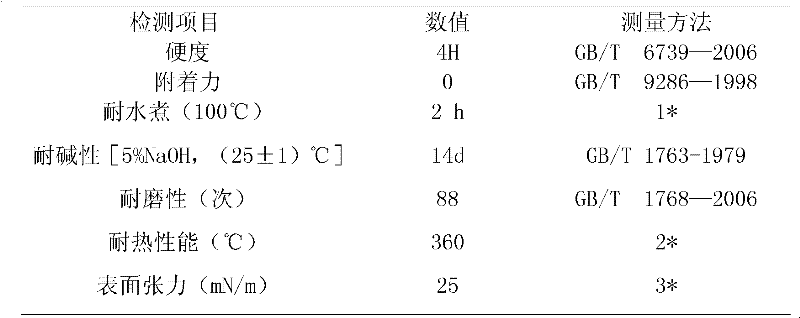Preparation method of modified organic silicon resin and paint containing prepared modified organic silicon resin
A silicone and resin technology, applied in the field of organic polymer compounds, can solve the problems of chemical resistance that cannot meet the requirements, reduce the water resistance of the coating film, poor mechanical properties of the coating film, etc., and achieve good metal adhesion and high heat resistance Good performance and adhesion
- Summary
- Abstract
- Description
- Claims
- Application Information
AI Technical Summary
Problems solved by technology
Method used
Image
Examples
Embodiment 1
[0034] 1) Amino-terminated hyperbranched polyamide
[0035] a) Composition:
[0036] Melamine: 126g (1.0mol);
[0037] Dibasic acid: 57.1g (0.5mol) of isophthalic acid; 49.8g (0.3mol) of terephthalic acid; 29g (0.2mol) of 1,6-adipic acid
[0038] b) synthesis steps:
[0039] Add melamine and dibasic acid into a reactor equipped with heating, condensation and nitrogen protection, raise the temperature to 110°C under nitrogen protection, and keep it for 2h; heat it to 240°C at a heating rate of 20°C per hour, and keep it at 1.33kPa for 4h; Finally, the room temperature was cooled to obtain 220 g of amino-terminated hyperbranched polyamide.
[0040] c) Properties of amino-terminated hyperbranched polyamides
[0041] The weight-average molecular weight of the amino-terminated hyperbranched polyamide was detected by gel permeation chromatography, and the result was 5001.
[0042] 2) Modified silicone resin
[0043] a) Composition:
[0044] Amino-terminated hyperbranched poly...
Embodiment 2
[0069] 1) Amino-terminated hyperbranched polyamide
[0070] a) Composition:
[0071] Melamine: 252g (2.0mol);
[0072] Dibasic acid: 99.6g (0.6mol) of isophthalic acid; 23.6g (0.2mol) of 1,4-butanedioic acid; 29g (0.2mol) of 1,6-adipic acid;
[0073] b) synthesis steps:
[0074] Add melamine and dibasic acid into a reactor equipped with heating, condensation and nitrogen protection, raise the temperature to 110°C under nitrogen protection, and keep it for 2h; heat it to 240°C at a heating rate of 20°C per hour, and keep it at 0.66kPa for 2h; Finally, the room temperature was cooled to obtain 364g of amino-terminated hyperbranched polyamide.
[0075] c) Properties of amino-terminated hyperbranched polyamides
[0076] The weight-average molecular weight of the amino-terminated hyperbranched polyamide was detected by gel permeation chromatography, and the result was 1992.
[0077] 2) Modified silicone resin
[0078] a) Composition:
[0079] Amino-terminated hyperbranched p...
Embodiment 3
[0099] 1) Amino-terminated hyperbranched polyamide
[0100] a) Composition:
[0101] Melamine: 176.4g (1.4mol);
[0102] Dibasic acid: 132.8g (0.8mol) of terephthalic acid; 29.2g (0.2mol) of 1,6-adipic acid;
[0103] Amino-containing alkyl carboxylic acid: glycine 3.75g (0.05mol); 3-aminopropionic acid 4.45g (0.05mol)
[0104] b) synthesis steps:
[0105] Add melamine, dibasic acid and amino-containing alkyl carboxylic acid into a reactor equipped with heating, condensation and nitrogen protection, raise the temperature to 110°C under nitrogen protection, and keep it warm for 2 hours; heat to 240°C at a heating rate of 20°C per hour, Insulated at 0.78kPa for 2.5h; finally cooled to room temperature to obtain 304g of amino-terminated hyperbranched polyamide.
[0106] c) Properties of amino-terminated hyperbranched polyamides
[0107] The weight-average molecular weight of the amino-terminated hyperbranched polyamide was detected by gel permeation chromatography, and the re...
PUM
 Login to View More
Login to View More Abstract
Description
Claims
Application Information
 Login to View More
Login to View More - R&D
- Intellectual Property
- Life Sciences
- Materials
- Tech Scout
- Unparalleled Data Quality
- Higher Quality Content
- 60% Fewer Hallucinations
Browse by: Latest US Patents, China's latest patents, Technical Efficacy Thesaurus, Application Domain, Technology Topic, Popular Technical Reports.
© 2025 PatSnap. All rights reserved.Legal|Privacy policy|Modern Slavery Act Transparency Statement|Sitemap|About US| Contact US: help@patsnap.com



